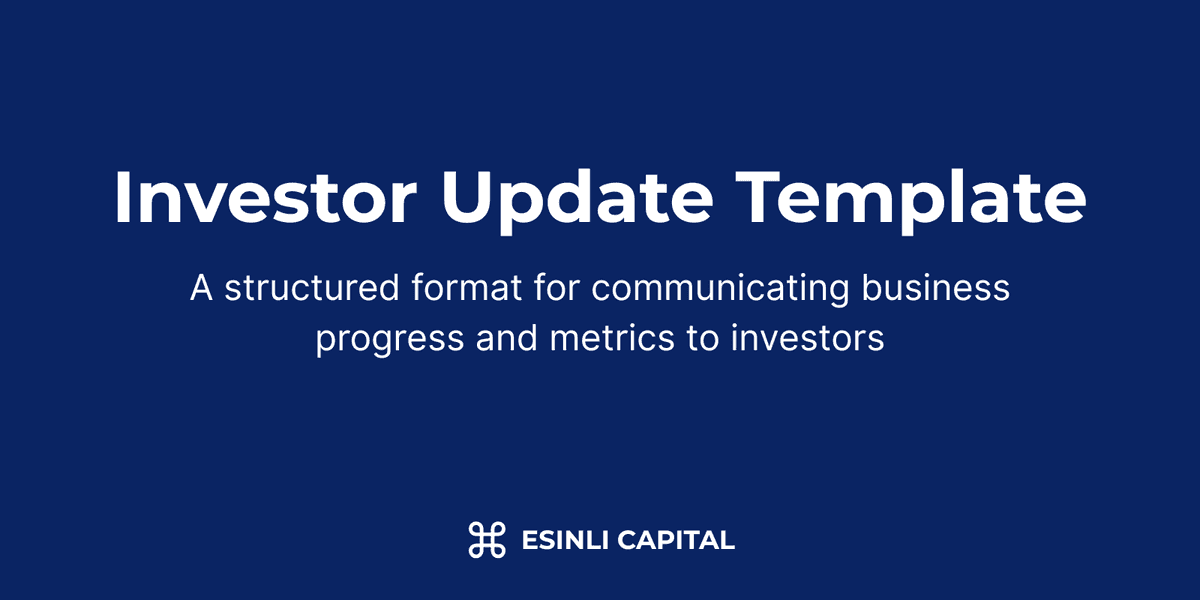In This Article
- What Is an Investor Update?
- Investor Update Template and Format
- How Often Should You Send Investor Updates?
- What to Include in Your Investor Update
- Investor Update Best Practices
- Investor Update Template Examples
- Common Investor Update Mistakes to Avoid
- How Investor Updates Impact Fundraising
- The Bottom Line
- What Is an Investor Update?
- Investor Update Template and Format
- How Often Should You Send Investor Updates?
- What to Include in Your Investor Update
- Investor Update Best Practices
- Investor Update Template Examples
- Common Investor Update Mistakes to Avoid
- How Investor Updates Impact Fundraising
- The Bottom Line

Investor Update Template: Format, Frequency & Content
KEY TAKEAWAYS
- Regular investor updates build trust, maintain relationships, and increase the likelihood of follow-on funding
- The ideal frequency is monthly for early-stage startups and quarterly for more established companies
- Effective updates include key metrics, milestones, challenges, asks, and future plans in a concise format
- Consistency in format and delivery timing matters more than perfect content
- Updates should be honest about challenges while maintaining an optimistic, solution-oriented tone
What Is an Investor Update?
An investor update is a structured communication sent to your startup's investors and key stakeholders that provides information about your company's progress, challenges, and future plans. These updates serve as a formal yet personalized way to maintain relationships with the people who have financially backed your venture, while also creating a documented history of your company's journey.
The primary purpose of investor updates is to foster transparency and maintain investor confidence. By providing regular insights into your business operations, you demonstrate accountability and a commitment to open communication. This builds trust with your current investors and can significantly improve your chances of securing additional funding in future rounds.
Components of an Effective Investor Update
A well-structured investor update typically includes several key sections:
- Executive Summary - A brief overview highlighting the most important developments since the last update.
- Key Metrics - Quantitative data about your business performance, including financial indicators and growth metrics.
- Milestones and Achievements - Notable accomplishments or progress toward previously stated goals.
- Challenges and Solutions - Honest assessment of obstacles faced and your approach to overcoming them.
- Team Updates - Changes in personnel, new hires, or organizational restructuring.
- Upcoming Goals - Short-term objectives and longer-term strategic plans.
- Requests for Assistance - Specific asks where investors might provide value beyond capital.
The exact format and depth of each section will vary depending on your company's stage, industry, and the preferences of your investor base.
Investor Update Template and Format
Creating a consistent format for your investor updates helps establish expectations and makes the information easier to digest. Below is a comprehensive template you can adapt to your specific needs:
Subject Line Format
Your subject line should be clear and consistent:
[Company Name] Investor Update - [Month/Quarter] [Year]
For example: "TechStartup Investor Update - March 2025" or "TechStartup Q1 2025 Investor Update"
Email Body Template
Dear Investors and Stakeholders,
I hope this update finds you well. Here's an overview of our progress at [Company Name] during [time period].
EXECUTIVE SUMMARY:
[2-3 sentences highlighting the most significant developments]
KEY METRICS:
- Revenue: [Amount] ([+/-]% from previous period)
- User Growth: [Number] ([+/-]% from previous period)
- Burn Rate: [Amount]
- Runway: [Time remaining]
- [Other relevant metrics for your business]
MILESTONES & ACHIEVEMENTS:
- [Key milestone 1]
- [Key milestone 2]
- [Key milestone 3]
CHALLENGES & SOLUTIONS:
- [Challenge 1]: [How you're addressing it]
- [Challenge 2]: [How you're addressing it]
TEAM UPDATES:
- [New hires, departures, or reorganization details]
- Current team size: [Number]
UPCOMING GOALS:
- [Short-term goal - next 30-90 days]
- [Medium-term goal - next quarter]
- [Long-term goal - next 6-12 months]
HOW YOU CAN HELP:
- [Specific request 1 - be concrete]
- [Specific request 2 - be concrete]
FUNDING STATUS:
- Current runway: [Months]
- [Fundraising plans if applicable]
I'm available for questions or discussions. Please don't hesitate to reach out.
Best regards,
[Your Name]
[Your Title]
[Company Name]
[Contact Information]
Visual Elements
Consider enhancing your update with:
- Simple charts or graphs showing key metric trends
- Product screenshots or mockups (if relevant)
- Team photos for major milestones
- Links to press coverage or significant content
Keep visual elements minimal and purposeful to maintain a professional appearance and ensure the email loads quickly.
How Often Should You Send Investor Updates?
The ideal frequency for investor updates depends on your company's stage and situation:
For Early-Stage Startups (Pre-Seed to Series A)
Monthly updates are typically recommended. At this stage, your business is evolving rapidly, and regular communication helps keep investors engaged and informed about your progress. Monthly updates also create a discipline of regular reflection and goal-setting for your team.
For Growth-Stage Companies (Series B and Beyond)
Quarterly updates often become more appropriate as your business stabilizes and the pace of fundamental changes slows. These can be more comprehensive and coincide with your board meetings or quarterly planning cycles.
Special Circumstances
Regardless of your standard cadence, consider sending additional updates when:
- You achieve a significant milestone
- You're approaching a new funding round
- You face a major challenge or pivot
- There are significant changes in leadership
- You receive major press coverage or industry recognition
Research shows that startups that send regular investor updates are 30% more likely to secure follow-on funding compared to those that communicate irregularly, highlighting the importance of consistent reporting.
What to Include in Your Investor Update
The content of your investor updates should be tailored to your company's specific context, but certain elements are universally valuable:
1. Key Performance Indicators (KPIs)
Track and report on metrics that matter most to your business model:
For SaaS companies:
- Monthly Recurring Revenue (MRR)
- Annual Recurring Revenue (ARR)
- Customer Acquisition Cost (CAC)
- Lifetime Value (LTV)
- Churn rate
- Net Revenue Retention
For Marketplace businesses:
- Gross Merchandise Value (GMV)
- Take rate
- Number of transactions
- Active buyers and sellers
- Repeat purchase rate
For Consumer products:
- Monthly Active Users (MAU)
- Daily Active Users (DAU)
- Retention cohorts
- Engagement metrics
- Conversion rates
For all businesses:
- Cash position
- Burn rate
- Runway
- Revenue (if applicable)
- Growth rates
2. Milestone Reporting
Effective milestone reporting includes:
- Achievement of previously stated goals: Referencing goals mentioned in previous updates creates continuity and accountability
- Product developments: New features, improvements, or technological breakthroughs
- Market traction: Customer wins, partnerships, or distribution agreements
- Team accomplishments: Key hires, organizational improvements, or culture wins
When reporting on milestones, be specific about their impact on your business trajectory and how they align with your overall strategy.
3. Challenges and Obstacles
Transparency about challenges is crucial for building investor trust:
- Identify specific obstacles you're facing
- Explain their impact on your business
- Describe your plan for addressing them
- If appropriate, request specific assistance from investors
Presenting challenges alongside your approach to resolving them demonstrates your problem-solving abilities and realistic outlook.
4. Strategic Asks
Effective investor updates include clear, actionable requests:
- Introductions to specific customers or partners
- Referrals for key positions you're trying to fill
- Advice on particular challenges
- Participation in upcoming fundraising efforts
Be specific about what you need and why it matters. Generic asks like "Let us know if you can make any introductions" are less effective than targeted requests.
Investor Update Best Practices
Implementing these best practices will maximize the impact of your investor communications:
1. Maintain Consistency
- Use a consistent format, making it easy for investors to find information they care about
- Send updates on a predictable schedule
- Track metrics consistently to show trends over time
2. Be Concise Yet Comprehensive
- Aim for updates that can be read in under 5 minutes
- Use bullet points and clear headings to improve readability
- Include links to more detailed information for those who want it
3. Balance Honesty with Optimism
- Be truthful about challenges and setbacks
- Maintain a solution-oriented, forward-looking perspective
- Avoid both excessive negativity and unwarranted optimism
4. Personalize When Appropriate
- Consider adding personalized notes for major investors
- Reference specific contributions or advice they've provided
- Acknowledge their unique value to your company
5. Close the Loop on Previous Asks
- Follow up on assistance requested in previous updates
- Thank investors who provided help
- Share outcomes from their contributions
6. Keep it Professional
- Proofread carefully for errors
- Maintain a consistent brand voice
- Ensure all data and claims are accurate
Investor Update Template Examples
Different stages and types of businesses require different approaches to investor updates. Here are tailored templates for specific scenarios:
Pre-Revenue Startup Template
Focus on:
- Product development progress
- User testing results
- Team building and capabilities
- Market validation efforts
- Runway and cash conservation
Post-Revenue Growth Stage Template
Emphasize:
- Revenue growth and financial metrics
- Customer acquisition efficiency
- Unit economics improvements
- Competitive positioning
- Market expansion opportunities
Hardware/Physical Product Template
Highlight:
- Supply chain and manufacturing updates
- Inventory levels and management
- Quality metrics and improvements
- Retail or distribution partnerships
- Production costs and margins
Common Investor Update Mistakes to Avoid
Even well-intentioned founders make communication errors. Avoid these common pitfalls:
1. Inconsistent Reporting
Sending updates sporadically signals disorganization and can erode investor confidence. Establish a consistent schedule and stick to it, even during challenging periods.
2. Overly Detailed Reports
Excessively long updates with too much detail can overwhelm investors and obscure the most important information. Focus on high-impact items and provide paths to additional details for interested parties.
3. Missing Context for Metrics
Reporting numbers without context or comparison points limits their usefulness. Always include:
- Comparisons to previous periods
- Comparisons to targets or projections
- Industry benchmarks when relevant
4. Avoiding Bad News
Delaying the communication of setbacks or challenges often makes the situation worse. Address problems proactively, along with your plan to resolve them.
5. Not Following Up on Previous Goals
Failing to reference goals from previous updates creates a disjointed narrative. Always close the loop on previously stated objectives, whether they were achieved or not.
How Investor Updates Impact Fundraising
Well-executed investor updates can significantly influence your fundraising outcomes:
Building Momentum
Regular updates that demonstrate consistent progress create momentum and social proof for future fundraising. They provide a track record that new investors can review to gain confidence in your execution abilities.
Warming Up Current Investors
For existing investors considering participation in your next round, updates serve as ongoing due diligence. Strong communication increases the likelihood of follow-on investment.
Creating FOMO
When your current investors are well-informed about your progress, they're better positioned to speak positively about your company to other potential investors, potentially creating FOMO (fear of missing out).
Demonstrating Maturity
The discipline of regular, high-quality reporting signals to investors that you take governance seriously and have the organizational maturity to manage larger investments.
According to a study by DocSend, startups that send monthly investor updates raise their next funding round 30% faster than those who communicate quarterly or less frequently.
The Bottom Line
Effective investor updates are a critical component of stakeholder management and long-term fundraising success. They require a balance of transparency, strategic communication, and consistent delivery.
By implementing a structured template, maintaining regular communication, and focusing on relevant metrics and milestones, you build investor confidence while creating a valuable record of your company's journey.
Remember that perfect is the enemy of good when it comes to investor communications. A simple update sent consistently is far more effective than an elaborate report delivered sporadically or a missed communication entirely.
Start with the templates provided in this guide, adapt them to your specific business context, and refine your approach based on investor feedback. The discipline of regular reporting will not only strengthen your investor relationships but also improve your strategic thinking and execution as a founder.



